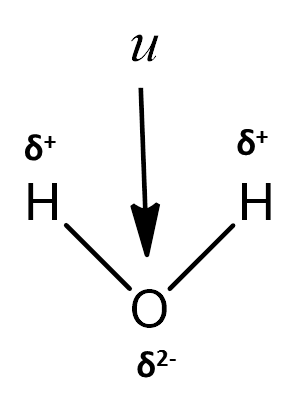
How do you calculate the dipole moment of water?
Answer
546.6k+ views
Hint: Dipole moment is a vector quantity means it has magnitude and direction. Dipole moment is a measure of polarity of chemical bonds present in between two atoms in a particular molecule. In dipole moment the separation of negative and positive charge takes place.
Complete answer:
- In the question they asked how we can calculate the dipole moment of water.
- There is a formula to calculate the dipole moment and it is as follows.
\[\text{Dipole moment (}\mu \text{) = charge (Q) }\times \text{ distance of separation (r)}\]
- Now coming to the calculation of the dipole moment of the water molecule.
- We know that the electrons are localized around the oxygen atom in the water molecule.
- The localization of electrons is due to the high electronegativity of the central oxygen atom in water molecules.
- Due to the presence of lone pairs of electrons on the oxygen molecule the shape of the molecule is going to be a bent shape.
- The shape and charge separation in the water can be seen in the following picture.

- The bond angle which is present in water is 104.5$^{o}$ .
- The individual bond moment of each hydrogen-oxygen bond is 1.5 D.
- There are two hydrogen in water molecules, the two hydrogen creates their individual dipole moments.
- We have to calculate the individual dipole moments and later we have to do the sum to get the dipole moment of the water molecule.
- The dipole moment caused by the left hydrogen in water molecule = $1.5D\times \cos ({{52.2388}^{o}})=15D\times 0.612 = 0.9187$
(Here, ${{52.2388}^{o}}=\dfrac{{{104.5}^{o}}}{2}$ )
- The dipole moment caused by the right hydrogen in water molecule = $1.5D\times \cos ({{52.2388}^{o}})=15D\times 0.612 = 0.9187$
(Here, ${{52.2388}^{o}}=\dfrac{{{104.5}^{o}}}{2}$ )
Therefore the net dipole moment of the water molecule = $0.9187 + 0.9187 = 1.837 D$.
Note: The unit to measure dipole moment of the molecules is D (Debye). The dipole moment for linear molecules like beryllium difluoride are 0. Because the dipole moment caused by individual fluorine atoms is zero.
Complete answer:
- In the question they asked how we can calculate the dipole moment of water.
- There is a formula to calculate the dipole moment and it is as follows.
\[\text{Dipole moment (}\mu \text{) = charge (Q) }\times \text{ distance of separation (r)}\]
- Now coming to the calculation of the dipole moment of the water molecule.
- We know that the electrons are localized around the oxygen atom in the water molecule.
- The localization of electrons is due to the high electronegativity of the central oxygen atom in water molecules.
- Due to the presence of lone pairs of electrons on the oxygen molecule the shape of the molecule is going to be a bent shape.
- The shape and charge separation in the water can be seen in the following picture.

- The bond angle which is present in water is 104.5$^{o}$ .
- The individual bond moment of each hydrogen-oxygen bond is 1.5 D.
- There are two hydrogen in water molecules, the two hydrogen creates their individual dipole moments.
- We have to calculate the individual dipole moments and later we have to do the sum to get the dipole moment of the water molecule.
- The dipole moment caused by the left hydrogen in water molecule = $1.5D\times \cos ({{52.2388}^{o}})=15D\times 0.612 = 0.9187$
(Here, ${{52.2388}^{o}}=\dfrac{{{104.5}^{o}}}{2}$ )
- The dipole moment caused by the right hydrogen in water molecule = $1.5D\times \cos ({{52.2388}^{o}})=15D\times 0.612 = 0.9187$
(Here, ${{52.2388}^{o}}=\dfrac{{{104.5}^{o}}}{2}$ )
Therefore the net dipole moment of the water molecule = $0.9187 + 0.9187 = 1.837 D$.
Note: The unit to measure dipole moment of the molecules is D (Debye). The dipole moment for linear molecules like beryllium difluoride are 0. Because the dipole moment caused by individual fluorine atoms is zero.
Recently Updated Pages
Master Class 12 Business Studies: Engaging Questions & Answers for Success

Master Class 12 Economics: Engaging Questions & Answers for Success

Master Class 12 English: Engaging Questions & Answers for Success

Master Class 12 Maths: Engaging Questions & Answers for Success

Master Class 12 Social Science: Engaging Questions & Answers for Success

Master Class 12 Chemistry: Engaging Questions & Answers for Success

Trending doubts
What is meant by exothermic and endothermic reactions class 11 chemistry CBSE

Which animal has three hearts class 11 biology CBSE

10 examples of friction in our daily life

One Metric ton is equal to kg A 10000 B 1000 C 100 class 11 physics CBSE

1 Quintal is equal to a 110 kg b 10 kg c 100kg d 1000 class 11 physics CBSE

Difference Between Prokaryotic Cells and Eukaryotic Cells




